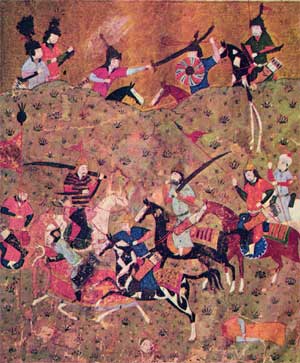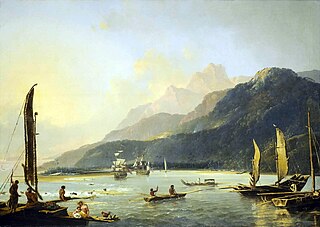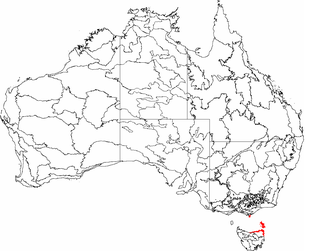
Year 1040 (MXL) was a leap year starting on Tuesday of the Julian calendar.

A marquess is a nobleman of high hereditary rank in various European peerages and in those of some of their former colonies. The German-language equivalent is Markgraf (margrave). A woman with the rank of a marquess or the wife of a marquess is a marchioness or marquise. These titles are also used to translate equivalent Asian styles, as in Imperial China and Imperial Japan.

Flinders Island, the largest island in the Furneaux Group, is a 1,367-square-kilometre (528 sq mi) island in the Bass Strait, northeast of the island of Tasmania. Today Flinders Island is part of the state of Tasmania, Australia. It is 54 kilometres (34 mi) from Cape Portland and is located on 40° south, a zone known as the Roaring Forties.

The Furneaux Group is a group of approximately 100 islands located at the eastern end of Bass Strait, between Victoria and Tasmania, Australia. The islands were named after British navigator Tobias Furneaux, who sighted the eastern side of these islands after leaving Adventure Bay in 1773 on his way to New Zealand to rejoin Captain James Cook. Navigator Matthew Flinders was the first European to explore the Furneaux Islands group, in the Francis in 1798, and later that year in the Norfolk.

Captain Tobias Furneaux was a British navigator and Royal Navy officer, who accompanied James Cook on his second voyage of exploration. He was one of the first men to circumnavigate the world in both directions, and later commanded a British vessel during the American War of Independence.

The Danish royal family is the dynastic family of the monarch of Denmark. While some members of the Danish royal family hold the title of Prince(ss) of Denmark, descendants of Margrethe II additionally bear the title Count(ess) of Monpezat. Children of the monarch are accorded the style of His/Her Royal Highness. The King and Queen are styled Majesty.

HMS Adventure was a barque that the Royal Navy purchased in 1771. She had been the merchant vessel Marquis of Rockingham, launched in 1770 at Whitby. In naval service she sailed with Resolution on James Cook's second expedition to the Pacific in 1772–1775. She was the first ship to circumnavigate the globe from west to east. After her return she served as a store ship until 1779. The navy sold her in 1783 and she resumed a civilian career, but retaining the name Adventure. She was lost in May 1811.

The House of Luxembourg or Luxembourg dynasty was a royal family of the Holy Roman Empire in the Late Middle Ages, whose members between 1308 and 1437 ruled as kings of Germany and Holy Roman emperors as well as kings of Bohemia, Hungary and Croatia. Their rule was twice interrupted by the rival House of Wittelsbach. The family takes its name from its ancestral county of Luxembourg which they continued to hold.
The Bosonids were a dynasty of Carolingian era dukes, counts, bishops and knights descended from Boso the Elder. Eventually they married into the Carolingian dynasty and produced kings and an emperor of the Frankish Empire.

The House of Habsburg-Lorraine originated from the marriage in 1736 of Francis III, Duke of Lorraine and Bar, and Maria Theresa of Austria, later successively Queen of Bohemia, Queen of Hungary, Queen of Croatia and Archduchess of Austria. Its members are the legitimate surviving line of both the House of Habsburg and the House of Lorraine and inherit their patrimonial possessions from their female line of the House of Habsburg and from the male line of the House of Lorraine.

Charles Furneaux (1835–1913) was an American painter and educator.

Yvonne Furneaux was a French-British actress. A graduate of the Royal Academy of Dramatic Art, she worked with notable filmmakers like Peter Brook, Federico Fellini, Roman Polanski, Michelangelo Antonioni, and Claude Chabrol, as well as in several genre productions.

The Friars are four steep dolerite rocks, with a combined area of about 17 ha, in south-eastern Australia. They are part of the Actaeon Island Group, lying close to the south-eastern coast of Tasmania, at the southern entrance to the D'Entrecasteaux Channel between Bruny Island and the mainland. They form part of South Bruny National Park.
Peter Furneaux was an English football club chairman and investor. He previously held the position of Executive Director at Grimsby Town where he was twice Chairman.

Some Like It Cold is a 1960 Italian war-comedy film directed by Steno.
William Mordaunt Furneaux was headmaster of Repton School and Dean of Winchester.
Philip Furneaux (1726–1783) was an English independent minister.
Henry Furneaux was a British classical scholar at the University of Oxford, specialising in the writings of the Roman historian Tacitus.

The Count of Monte Cristo is a 1961 French adventure film version of Alexandre Dumas' 1844 novel directed by Claude Autant-Lara and starring Louis Jourdan, Yvonne Furneaux, Pierre Mondy and Franco Silva.

Furneaux is an interim Australian bioregion that comprises the Furneaux Group, consisting of over one hundred islands off the northeast coast of Tasmania, as well as the northeast corner of Tasmania and Wilson's Promontory on the Australian mainland. It spans an area of 537,543 hectares.














